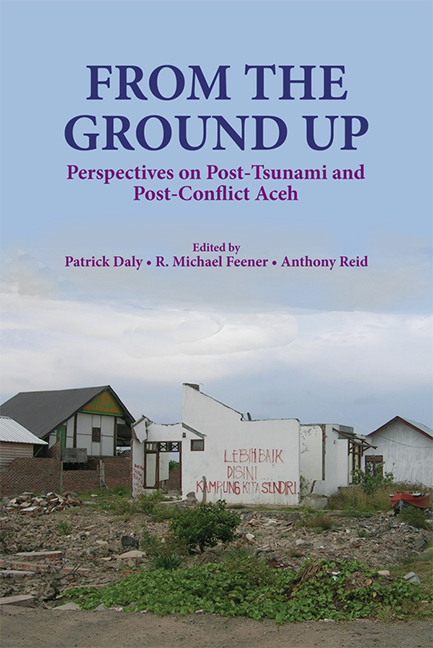Book contents
- Frontmatter
- Contents
- Preface
- List of Figures and Tables
- The Contributors
- Glossary and Abbreviations
- Introduction: Unpacking the Challenges of Post-2004 Aceh
- 1 The Sunda Megathrust: Past, Present and Future
- Part I Reconstruction Efforts
- Part II Conflict Resolution
- 9 Managing Risk: Aceh, the Helsinki Accords and Indonesia's Democratic Development
- 10 Making Peace Agreements Effective: The Aceh Monitoring Mission Experience
- 11 Justice and the Aceh Peace Process
- 12 Managing Peace in Aceh: The Challenge of Post-Conflict Peace Building
- Index
11 - Justice and the Aceh Peace Process
from Part II - Conflict Resolution
Published online by Cambridge University Press: 21 October 2015
- Frontmatter
- Contents
- Preface
- List of Figures and Tables
- The Contributors
- Glossary and Abbreviations
- Introduction: Unpacking the Challenges of Post-2004 Aceh
- 1 The Sunda Megathrust: Past, Present and Future
- Part I Reconstruction Efforts
- Part II Conflict Resolution
- 9 Managing Risk: Aceh, the Helsinki Accords and Indonesia's Democratic Development
- 10 Making Peace Agreements Effective: The Aceh Monitoring Mission Experience
- 11 Justice and the Aceh Peace Process
- 12 Managing Peace in Aceh: The Challenge of Post-Conflict Peace Building
- Index
Summary
Justice is a tricky word. Everybody makes claims for it and in its name, but very few would be able to explain exactly what it means. This is not because of ignorance, but rather due to the wide scope the term is assumed to cover, and the ambiguities attached to it in its everyday use. Justice — or keadilan in Indonesian — is one of the most common terms used when discussing post-conflict processes in Aceh. The absence of justice or the failings of the justice system are seen as major problems in post-conflict reconstruction — and these are addressed through programmes aiming to improve people's access to justice in Aceh. Justice is the key word for local civil society groups that seek to improve its realization and, now and then, to bring their own forms of justice to people in the villages. And justice is what is at stake when the victims of conflict lament that, despite all of the good promises, none of the terrible wrongs they experienced during the conflict have been made right. They are still waiting for justice.
In this chapter, I discuss the question of justice in Aceh's post-conflict reconstruction and peace-building. I argue that to maintain sustainable peace in the territory, it is important to have the widest possible consensus on what is understood by “justice” in post-conflict Aceh. So far, much of the justice talk in the Aceh peace process has been limited to transitional justice issues. Post-conflict reconciliation takes place in relation to institutionalized forms of justice such as human rights courts and truth and reconciliation commissions that seek to provide justice and reconciliation between victims and perpetrators. However, the process of peace-building and reconstruction must also be sensitive to Acehnese views on how a just society should be constructed. This includes talk about social justice, the rights and obligations of members of a society towards each other, as well as the relations between the state and its citizens.
- Type
- Chapter
- Information
- From the Ground UpPerspectives on Post-Tsunami and Post-Conflict Aceh, pp. 225 - 241Publisher: ISEAS–Yusof Ishak InstitutePrint publication year: 2012



